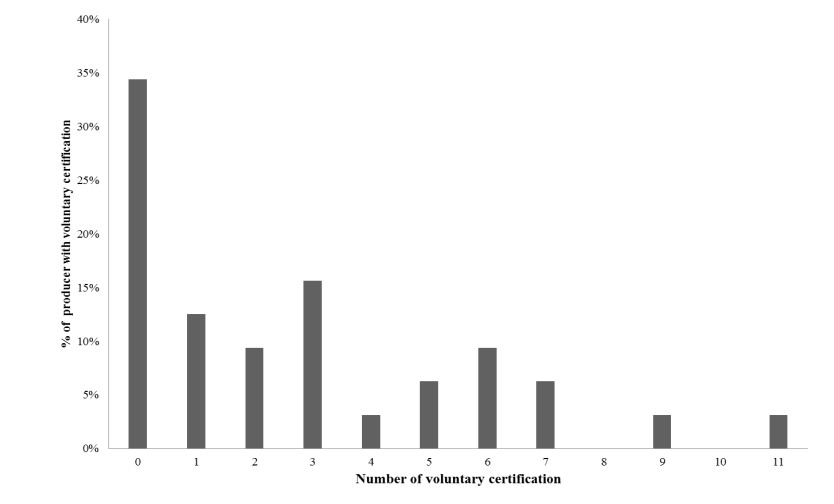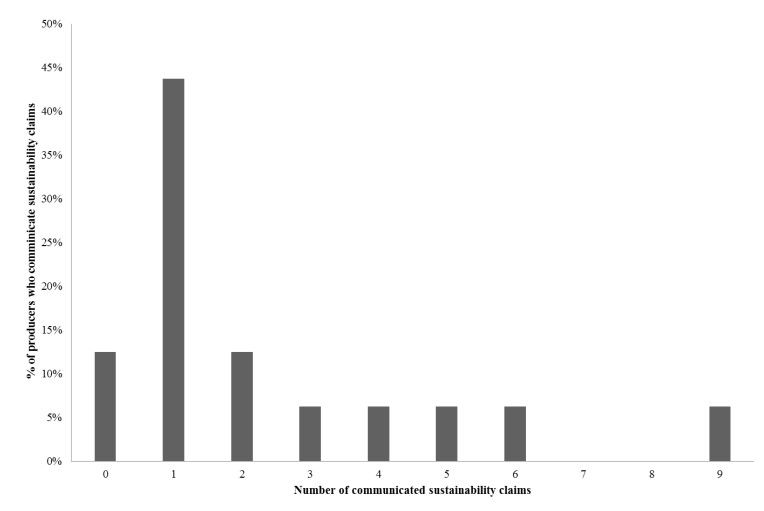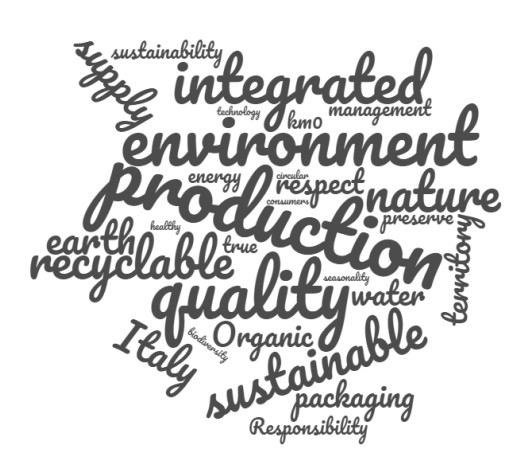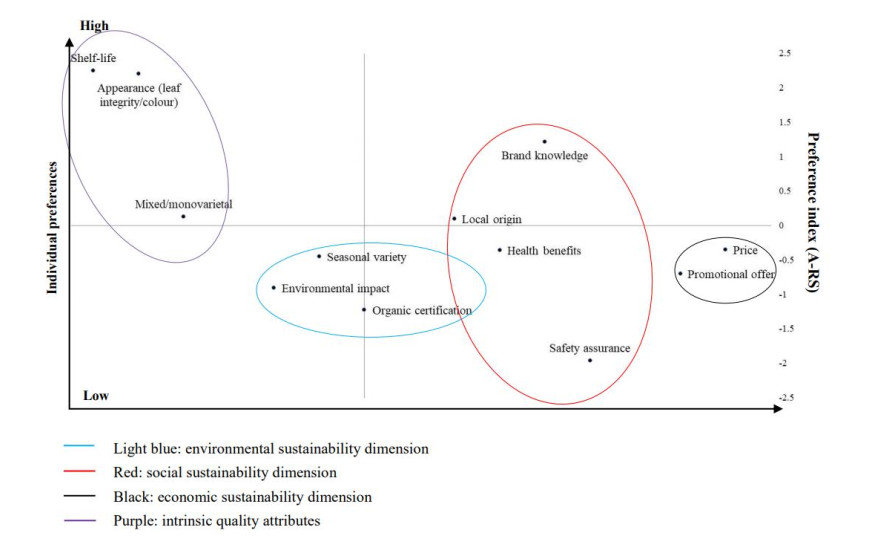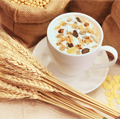Fresh-cut salads are ready-to-eat foodstuffs with a growing market share and increasingly popular with consumers. However, a significant part of public opinion considers that bagged salad production processes have an effect on sustainability. In parallel, fresh-cut salads producers implement high resources and innovation strategies to improve the production process and product sustainability, highlighting an increasing awareness of their responsibility. The objective of this study was to investigate whether a correspondence exists between consumer preferences and the fresh-cut salad sustainability attributes (environmental, economic and social), indicated by producers (on their packaging and/or company website). Consumer preference analysis of 12 attributes of fresh-cut salads was made using the Best-Worst scaling methodology. Among the selected attributes, 9 were related to sustainability issues and 3 to the intrinsic product characteristics. A paper questionnaire was developed and submitted directly to consumers (n = 216), at different points of sale of several large retail chains in the Turin metropolitan area (Northwest Italy). The analysis of the results highlights that no direct correspondence can be found between the companies’ communications regarding sustainability and the real interest of consumers of fresh-cut salads towards these attributes. Moreover, in contrast to the growing ‘green’ attitude among consumers, the lack of consumer interest in the attributes of environmental sustainability underlines the need to increase consumer awareness of the issue. Thus, this research could contribute to the development of more targeted and accessible communication strategies towards consumers.
1.
Introduction
Consumers are becoming increasingly attentive and aware during food purchases, directing their choices towards sustainability choice attributes [1]. Sustainable consumption can be defined as “consumption that simultaneously optimizes the environmental, social and economic consequences of acquisition, use and disposition to meet the needs of present and future generations” [2].
This attitude in the “consciousness for sustainable consumption” (CSC) model, defined by Balderjahn et al. (2013) [3] influences product evaluation mechanisms with regard to aspects of environmental sustainability (awareness of the importance of environmental protection during the production process, consumption and disposal of the product) [4,5]. It also includes social issues (respect for human rights, rejection of discrimination and child labor, fair compensation, in addition to revival of local products, linked to tradition and territory) and economic issues (which guarantees a profit, as well as the survival on the market of small local businesses run, for example, at family level) [6,7,8]. A product differentiation strategy on the market must therefore include the development of sustainability attributes that reflect environmental and social pressures, in line with consumer preferences [9]. In recent years, agricultural producers have introduced innovative production and processing systems in order to achieve high standards of process and product sustainability and innovation in consumer communication strategies [10]. The latter focus on distinctive aspects related, for example, to the lessening of environmental impacts [11], the use of recycled or recyclable materials in packaging [12,13,14] and the reduction or elimination of pesticide and insecticide use [15,16]. In addition, producers are also focusing their product innovation and differentiation strategies on aspects related to social sustainability, linked, for example, to the revival of traditional recipes, local/territorial origins and a short supply chain [17,18,19].
These production guidelines are in line with international voluntary certification standards, such as those issued by the International Organization for Standardization (ISO) (i.e. ISO 14001, ISO 14025), which address the problem of sustainable production, including economic, social and environmental needs [20,21]. One of the most important private standards for primary production is the GlobalGAP system. GlobalGAP is voluntary and sets certification standards and procedures for good agricultural practices, food safety, environmental protection, food traceability, health and safety of employees and animal welfare [22].
In Italy, constant growth has been recorded in fresh-cut fruit and vegetable consumption and, more specifically, of fresh-cut salads. Regarding these products, consumers recognize the health benefits, the high-service content and the maximum efficiency of the product linked to the reduction of domestic waste [23]. In the first three months of 2019, sales of fresh-cut salads in Italy increased by 6.7% and the volume purchased also grew by 9.8%, compared to the same period of 2018 [24]. Moreover, according to Nomisma research on Nielsen data from 2017, Italy is the leading European country in terms of per capita consumption, with over 1.6 kg of fresh-cut salads consumed per person each year [25].
Despite their popularity, public opinion also acknowledges that these products may be carriers of pathogens such as Escherichia coli, Salmonella spp., Yersinia enterocolitica, Shigella spp., Listeria monocytogenes and of viruses, such as Norovirus and Hepatitis A virus (HAV) [26]. In addition, bagged salads are negatively evaluated due to the use of chemicals (fertilizers, herbicides, pesticides) in the cultivation phase, in addition to the elevated water waste of the washing phase [27], the excessive use of non-renewable energy resources, and the use of non-biodegradable and/or recyclable plastics. In response to these latter aspects negatively perceived by consumers, this sector has developed an increasingly strong vocation in recent years towards innovation implemented to improve the cultivation, production and packaging processes of fresh-cut salads, with the aim of reducing their environmental impact and to increase safety. Fusi et al. (2016) [27] found that using appropriate wastewater filtration technologies to enable reutilization, in addition to reducing the amount of water used, can significantly reduce sea eutrophication, climate change and photochemical oxidant formation in the environment. Regarding environmental sustainability, the same authors also discussed that the processing of bagged fresh-cut salads does not produce a higher water use and ecological footprint compared to its cultivation. Regarding economic sustainability, these products can be considered a way to increase the agricultural production value (for their high-service content) since they maintain the characteristics of fresh products. Fresh-cut salads can also be considered socially sustainable because they raise the level of food standards by providing safer and more varied products and allow a wider diffusion of agricultural products among the Italian population [28,29]. Several producers at a national level promote process innovation and certified production practices (on a voluntary basis), aimed at increasing sustainability. These are mainly focused on the development of better agricultural technologies and practices to reduce water consumption, especially during salad washing, and the use of pesticides or pesticide reduction during cultivation. Producers have therefore activated marketing strategies for the communication and promotion of salads, based on claims that call attention to their differentiation on the market, as active supporters of sustainable production processes and products for the implementation, for example, of more sustainable innovative irrigation/fertilization techniques [23] and the use of innovative and recyclable packaging. In parallel, Grunert et al. [30] have demonstrated that the majority of consumers associate the term sustainability primarily to environmental protection aspects and, to a lesser extent, with ethical or social issues [31].
1.1. Research aims
The first hypothesis (H1) of this research was that fresh-cut salads producers implement and communicate the innovative management techniques and policies they adopt in order to increase product/process sustainability. To this end, a preliminary exploratory survey was carried out to analyze which sustainability claims/slogans implemented by 32 Italian fresh-cut salad producers were used and communicated to consumers. In addition, assuming, at the same time, a strong consumer awareness of sustainability issues and that the latter represent a driver during fresh-cut salads choice and purchase (H2), the research included the analysis of consumer preferences towards fresh-cut salad attributes of environmental, social and economic sustainability. With this aim, the quantitative Best-Worst scaling (B-W) methodology was implemented in a choice experiment conducted through face-to-face interviews of consumers intercepted at various points of sale of large-scale retail trade in the metropolitan area of Turin (Northwest Italy) [32,33,34]. Finally, the potential correspondence between consumer preferences and the communication strategy characteristics regarding the innovation tools adopted by fresh-cut salad producers to improve product/process sustainability was discussed.
2.
Materials and methods
2.1. Reviews of sustainability claims used by fresh-cut salad producers in Italy (Hypothesis 1)
The first research hypothesis (H1) aimed to verify if the companies producing fresh-cut salads communicated in a widespread manner the innovative management techniques and policies implemented to increase process and product sustainability. An in-depth investigation was carried out on the websites of 32 Italian companies producing fresh-cut salads, analyzing the claims/slogans related to sustainability, both product and process, communicated to the consumer. To select the producers, we started the research by analyzing the fliers and the product lists that the main retail chains distributed nationwide publish on their websites. More specifically, the websites of 13 supermarket chains, 2 hypermarkets and 3 discount stores were analyzed. After this first step, 32 producers of fresh-cut salads were selected for the research aim and the survey focused on the examination of their company websites.
Since the websites may be structured differently and involve a different search effort by the user (e.g. to search for particular information, not published on the home page), the analysis included: the examination of the home page, the dedicated pages and the packaging of the products described and purchasable online. In total 32 company websites (coded with progressive numbers) were analyzed. In the analysis of each selected company website the voluntary certifications, claims and slogans were recorded and categorized within the three sustainability dimensions (economic, environmental and social). This information was also compared with those communicated directly on the product packaging.
2.2. Consumer preferences analysis (Hypothesis 2)
The second research hypothesis (H2) aimed to verify if consumers positively perceive the attributes related to fresh-cut salads sustainability (environmental, social and economic) and consider them as drivers during the product purchasing process.
The degree of preference expressed by the consumer sample towards different attributes (intrinsic, environmental, social and economic sustainability) of fresh-cut salads was determined. Following an in-depth bibliographic research, 12 descriptive attributes of this product were selected (Figure 1). The attributes were chosen according to the sustainability categories corresponding to the claims, certifications and slogans used by salad producers to communicate to the consumer a greater process or product sustainability, deriving from innovative technologies, systems and material implementation. In addition, since consumers give importance to the intrinsic attributes of the product during purchase, both for fresh-cut salads [28,34], and for food and beverages in general [35,36,37,38], 3 attributes related to the quality of the salads (variety, appearance, expiration date) were also selected.
2.2.1. Intrinsic quality cues
Among the intrinsic attributes of fresh-cut salads, the consumer directly establishes the product appearance and variety by means of a visual evaluation. Moreover, product appearance is perceived as synonymous of product quality and freshness [39]. Although the expiration date is an attribute that provides the buyer with an indication of the shelf-life of the product, it thus indirectly also provides information on the freshness and safety of the product [28,40], as well as on convenience [41]. Additionally, the variety of salad and the bag composition - mixed varieties (i.e. iceberg, radicchio and baby spinach) vs. single variety in the bag (i.e. only iceberg or radicchio) - whose consumer choice may be linked to seasonality, as well as to personal taste, appear to be drivers of consumer preference [42,43].
2.2.2. Environmental sustainability attributes
Within the environmental sustainability dimension, the following attributes have been included: organic certification, environmental impact and seasonal product. Organic certification is indicative of eco-friendly production as it promotes best environmental practices and actions for the climate, a high level of biodiversity and the conservation of natural resources [10,44,45]. The assessment of the environmental impact of products can be carried out during the selection and purchase of the product by examining the information provided by the manufacturer, such as environmental certifications or agricultural practices (open field or not) [46,47].
Finally, the choice of a seasonal product is closely related to an environmentally oriented purchasing behavior as it allows the selection of products grown spontaneously on the land, without the use of greenhouses and covers, avoiding excessive waste production [34,48,49,50].
2.2.3. Economic sustainability attributes
Price and promotional offer were evaluated as attributes related to the dimension of economic sustainability. The consumer price evaluation can assume two conflicting meanings, corresponding to two price-conscious consumer profiles. The first bracket, often called “value for money” individuals [34,42] evaluate the product price, considering this to be an index of quality, as they view the price/major quality relationship an important choice driver. The second profile, called “price sensitive” consumer [36,42] is represented by individuals attentive to promotional offers and product prices in order to preserve the family budget [34]. In general, consumers aware of the existence of economic sustainability pay attention to the quality/price ratio; economic sustainability is linked to safeguarding the economy of companies and producers who develop quality production systems, meaning the product is sold at a higher price [51]. However, consumers are generally disappointed by the “expiration date-based pricing” (EDBP) discount strategies adopted by some Italian supermarkets. Frequently, this is a technique used on fresh products characterized by a short shelf life with the aim of encouraging the purchase by consumers, also ensuring a lower level of food waste [52].
2.2.4. Social sustainability attributes
The social sustainability dimension included the following attributes: local origin, health benefits, brand knowledge and safety assurance. Consumers have now adopted consumption patterns for local food because it is considered more environmentally and climate-friendly [17,18]. Moreover, short supply chains are perceived as more reliable thanks to increased direct communication between producers and consumers [53]. Local food can promote local employment and help these businesses to access the market [6], while consumers can feel that they are supporting the community when they buy locally produced food [45]; these are the reasons why “local origin” should be considered a social attribute.
The brand provides consumer recognition of the product, its producer and of the connected values, including the social aspect. Companies, through their brand, can be identified by consumers as defenders of the economy and as market players supporting economic structures [54]. The policies promoted by companies, the values communicated through the brand are recognized by the consumer and contribute to create the perception of the brand itself in the consumer’s mind. For example, rejecting child exploitation, forced labor and discrimination, promoting equality, fair working hours, freedom of association and ensuring health and safety are some of the practices commonly used by companies as social criteria of sustainability [8]. Brand knowledge affects consumer loyalty towards the product.
The foodstuff nutritional value stated on the label is not always consulted by consumers. This habit could depend on the type of food. For example, this attribute is neglected in foods such as milk or meat [36,55], whereas it is considered in functional foods [56] or by consumers with particular dietary needs related to their health conditions [57]. The intrinsic characteristics of fresh-cut salad related to its health benefits represents an added value for consumers, in addition to the product convenience [42]. The product may also be negatively discriminated by consumers, due to the potential health risks linked to its consumption [26]. As food safety is defined as an indicator of social sustainability (referring to the people dimension) [58], the safety assurance evaluation was included in the social sustainability attributes group.
2.2.5. The Best-Worst scaling methodology
The selected attributes (Figure 1) were implemented in the paper questionnaire following the B-W scaling methodology approach [59] and submitted face-to face to the consumer during the choice experiment. This methodology is an extension of the traditional discrete choice methods for consumer study (based on the detected preferences) allowing the definition of the directly declared consumer preferences, avoiding problems of individual answer detection and reliability [60]. In our research, the interviews were conducted at various points of sale of large-scale retail outlets in the metropolitan area of Turin (Piedmont, Northwest Italy), in order to define the degree of preference expressed by the consumer sample (n = 216) for each identified attribute. With this aim, the 12 attributes were distributed in 9 sets of 4 items each. In addition, 4 different versions of the questionnaire were created to increase the attribute combination, allowing a greater variability of answers and to minimize errors. In each version, each single attribute appears 3 times. For each box of 4 attributes, the participants selected the most important and the least important attribute taken into consideration during fresh-cut salad purchases. During the interviews, the individual interviewees identified the pair of maximum difference (the best and the worst attribute) [61], in each table. This is the reason why this methodology is also known as MaxDiff [62]. The answers collected through the questionnaires were processed using Sawtooth Software (v.2.0.2, Orem, UT, USA) which provided a preference score or average raw score (A-RS) for each attribute, that allowed all the items to be ranked on the basis of the declared consumer preferences. The A-RS for each attribute is calculated as the ratio between B-W (the number of times the attribute was chosen as BEST, minus (-) the number of times the attribute was chosen as WORST) and the frequency with which the single attribute appears in the questionnaire (s = 3), multiplied by the sample number (N). This preference index can be a positive or negative number: negative A-RS indicates a lower preference expressed by the sample for the considered attribute, compared to the average of the preferences of the sample. A graphical representation of the A-RS of the single attributes in a two-dimensional space was elaborated to highlight the consumer choice orientation towards each considered sustainability dimension, as well as to the intrinsic fresh-cut salads attributes. To this aim, we allocated the 12 attributes to the x-axis, ordered and grouped according to the dimensional membership. The y-axis shows the preference index (A-RS).
The final part of the questionnaire was dedicated to the survey of the respondents' socio-demographic characteristics (gender, age, place of residence, educational background, family composition, employment and average annual household income).
3.
Results
3.1. Communication strategies applied by fresh-cut salad producers
Of the companies analyzed, 34% did not have voluntary process or product sustainability certifications. In addition, the number of certifications per company varied widely, ranging from a minimum of 1 certification to a maximum of 11 different certifications per company (Figure 2). In general, 38% of the companies analyzed had between 1 and 3 certifications.
The percentages of the companies that communicate their certifications/claims regarding the sustainability of the production/product process on their company website, together with the specific point on the website where they state them (homepage, dedicated page, product packaging) are shown in Table 1. From the data reported in Table 1, it emerges how fresh-cut salad producers certify their production process or their product mainly with 11 types of voluntary certifications, obtainable against payment, which enable them to conform to national and international standards, in the context of greater environmental, social and economic sustainability. The most frequently used certifications were IFS (International Featured Standards) and GlobalGAP that the producers generally communicate on a dedicated page. Overall, 40% of these certifications fall within the three dimensions of sustainability (ISO 9001:2015, GlobalGAP, Organic, Linking Environment and Farming—LEAF and Vegan), while the others are specific to one or two dimensions. A particular case is organic certification, since 12 companies present this certification and it is also the only one that is communicated on the product packaging. Only one company communicated the ISO 9001:2015 certification, not only on the company website, but also on the salad packaging. Generally, companies therefore choose to communicate sustainability certifications on the company website, on the homepage or on a dedicated page. Only four companies did so on both. As regards the use of claims relating to the improvement of process or product sustainability by manufacturing companies, only four of the 32 companies analyzed (12%) did not include them in their communication strategies on the company website. Additionally, in the case of the claims, these were communicated on the website mainly on a dedicated page. However, unlike certifications, claims are also included on the product packaging.
1 https://www.csqa.it/CSQA/Norme/Sicurezza-Alimentare/Filiera-controllata accessed on 6/11/2019
The number of claims within the individual company websites ranged from a minimum of 1 to a maximum of 9 (Figure 3).
Of the companies analyzed, 22% did not use slogans designed to clearly and directly communicate the added value of the process or product related to sustainability. A slogan, by definition, is designed by individual companies to remain imprinted in the consumer's mind and has the function of connecting the product, not only to the brand, but also to the image of the company itself. In this regard, the communication of innovation for sustainability is a message presumably perceived in a positive way by the consumer. From Figure 4, it emerges how the slogans found in the analyzed sites contained the words; environment, production, recyclable, sustainable, integrated, but also Italy, territory and packaging. Therefore, it clearly emerges how the slogans designed by the individual companies are focused on environmental sustainability aspects and integrated production systems, but also on the importance of the territory of origin and product packaging.
3.2. Consumer preference evaluation using the best-worst scaling approach
The sample involved in the research was composed of 216 individuals whose socio-demographic characteristics are described in Table 2.
The sample was mainly composed by women balanced across the different age brackets, with the exception of younger people (aged between 18 and 30 years) who represented a minority, with a high level of education and a low to medium household income.
The preference degree (A-RS) expressed by the interviewees for each fresh-cut salad attribute is shown in Table 3. The sample evaluated the shelf-life of the product as the most important attribute for the choice of fresh-cut salads (A-RS = 2.256), followed by the appearance (leaf integrity and color) (A-RS = 2.205) and the knowledge of the product brand (A-RS = 1.219). Conversely, respondents placed safety assurance (A-RS = −1.958), organic certification (A-RS = −1.220) and product promotion (A-RS = −0.899) among the least important attributes.
The graphical representation in a two-dimensional space of the A-RS of each attribute included in the research enables a better evaluation of how the different attributes merge within the 3 dimensions of sustainability, and also within the group of intrinsic attributes (Figure 5). Therefore, an orientation of evaluation of the attributes, in accordance with their grouping within the considered categories emerges. The attributes represented below the abscissae axis are those evaluated positively by the consumer (with a positive A-RS, i.e. higher than the average value, which therefore received more BEST evaluations, rather than WORST), while the attributes positioned below the x-axis are those with negative A-RS (resulting from an evaluation of importance below the average value of A-RS). The intrinsic attributes of the product were all evaluated as important in the choice of fresh-cut salads, while those related to the social sustainability dimension were found to be of partial interest by the consumer: in fact, only the knowledge of the brand and the local origin were evaluated positively as important by the interviewees, while the safety and health benefits of the product were not recognized as important attributes for the choice. Both dimensions of economic and environmental sustainability were not considered discriminatory during the consumer's purchasing process of fresh-cut salads.
4.
Discussion
4.1. Evaluation of the correspondence between consumer preferences and the communication strategies used by fresh-cut salad producers relating to innovation/improved methods linked to product and process sustainability
From the research results analysis, it emerges that the communication strategies adopted do not fully correspond to consumer demand. Firstly, although the examined companies focus their marketing strategies on the communication of environmental sustainability claims, slogans and voluntary certifications (the first hypothesis—H1—can be accepted), the consumers involved did not consider this dimension a discriminant of their choices. In particular, it is important to underline that certifications, which imply an additional cost for producers, are not communicated on the product packaging but rather, for the majority of the companies analyzed, exclusively on the website. The only exception was organic certification that is always communicated, even as an integral part of the name of the product itself, on the packaging. Furthermore, not even the slogans and claims (water and energy reduction, use of recyclable packaging, control of greenhouse gas emissions, etc.), often communicated directly on the packaging and therefore easily accessible and without the need for consumers to interpret the message, are not perceived as factors influencing the purchase of the product by the sample involved. This consumer attitude is in contrast with other researches in literature which showed a marked ‘green’ attitude of individuals in the choice of food products [101,102,103] and also towards some fresh-cut salads [104]. At the same time, giving consumers the opportunity to find sustainability information on labels does not necessarily mean that they will actually purchase them, as this depends on individual motivations [57,105]. The more consumers are concerned about sustainability issues in food production, the more likely it is that they will develop an awareness that enables them to develop a sustainable consumption attitude based on a decision-making process that takes into account the social responsibility of the consumer, as well as individual needs [106,107]. Vermeir and Verbeke (2006) [108], for example, explained how low purchasing intentions towards sustainable products are related to a perceived low availability of sustainable products, although attitudes could be positive. However, the same study showed that more sustainable food consumption can be stimulated by increasing involvement, certainty, social standards and perceived availability. These reflections are true when discussing the responsibility of individuals of their role in protecting the environment, but are equally true for social responsibility. However, perhaps for the latter aspect, consumers feel less responsible and actively involved, if not directly concerned, by issues related to human rights, safety, worker’s labor and living conditions [109]. In this case, they maintain that the greatest responsibility is attributed to domestic and international political strategies and therefore depends on the legislator and the body exercising executive power [105,109]. Although a niche group of consumers who reflect on the ethical consequences of their purchasing behavior is growing, there is evidence that child labor free and fair trade products often have market shares of less than 3% [110].
As far as organic certification is concerned, it has not been found to be a discriminatory attribute in the choice of the product. Nevertheless, in general, it is of major importance in consumer choices [111], for example, for certain animal products, and also in the case of fresh-cut salads [36,112].
The attributes of social sustainability recognized as important by the consumer of fresh-cut salads were the brand knowledge and the local origin. The latter result is in contrast with the survey carried out by Massaglia et al. (2019) [42] in which the brand was evaluated as an unimportant attribute by the consumer when purchasing fresh-cut salads. However, the comparison with these results must take account of the investigative context, which in the case of the abovementioned research concerned both large retail distribution outlets and open markets. The assessment of the brand by the consumer who buys from retail outlets is therefore discriminated against because it reflects the individual's loyalty to a known brand, which they trust [113,114]. At the same time, the local brand, which in a study [34] was positively evaluated by a target group of consumers (local sensitive), in this case was perceived positively by the whole sample. In the context analyzed, in fact, several local brands of fresh-cut salads have emerged on the market and are therefore perceived positively by consumers [115]. In this regard, several studies have observed that consumers may perceive the concepts of ‘organic’ and ‘local’ as partially overlapping [116,117]. However, while local food is still not a fully defined concept, the organic food system is more developed, for example, by means of certified labeling programs. Due to the increasing global standardization and industrialization of organic food, several authors have argued that organic farming has lost some of its prestige as an alternative to conventional agriculture and that this has caused a shift in consumer preferences from organic to local products. As a result, local origin food has been defined in some environments as the ‘new organic’ [115,116].
In general, it is important to point out that the lack of understanding of some sustainability labels or claims can lead to consumer confusion or even negative reactions, even if the purpose of these labels is precisely to reduce the information gap between producers and consumers regarding product characteristics or brand value [118].
In addition, in this study, low importance was given by the respondents to attributes relating to the economic dimension of sustainability. As far as promotional offers are concerned, this result confirms other studies in which a negative association emerges between product quality and offer in the consumer's mind [34,119]. The negative evaluation of the product price by the examined sample could represent an unexpected result. However, for this same product, the differentiation of supply within the large retail sector could make it easier for the purchasing manager to consider the price as a discriminatory element in the choice of the product. In conclusion, the second hypothesis can be partially accepted, highlighting an interest of consumers specifically towards the social sustainability dimension.
Concerning the intrinsic attributes of fresh-cut salads, the results showed a high consumer interest towards product appearance, shelf-life and type. In particular, the expiration date and visual appearance are related to freshness and organoleptic quality, as well as to product safety [43]. In addition, the shelf-life of the product is evaluated by the consumer with a view to limiting waste as demonstrated in Alongi et al. [120], where the effect of the communication of the expiration date on acceptability was studied, in addition to the risk of waste, relating to consumers of fresh-cut salads. In this study, the negative effect of the communication of the expiration date on the consumers’ decision to purchase emerged, related to the fear of wasting food.
5.
Conclusion
Communication and marketing strategies are playing an increasingly important role in achieving sustainability objectives, giving consumers the opportunity to consider the environmental, social-ethical and economic impacts of their food choices. Although the so-called sustainability labels or certification logos are considered key tools to inform consumers about the impact of their food choices, this research shows that consumers of fresh-cut salads make their choices guided by preferences towards intrinsic attributes and the convenience of the product examined. This study therefore confirms the high involvement of fresh-cut salad producers in the communication of claims and slogans, concerning their responsibility towards sustainability. However, despite the important communicative effort made by fresh-cut salad producers, this research shows that the attributes related to the different sustainability dimensions were not important in product choice. In particular, consumers base their purchases primarily on product appearance and shelf-life, and therefore on intrinsic quality attributes. This research could represent an important contribution to the fresh-cut salad production sector that must maintain environmental and social protection policies in place, but at the same time, should find more effective communication tools to increase awareness of the actions taken at the supply chain level. However, among the limits of this research, there is the confined area taken into account (metropolitan area of Turin) which, therefore, could be extended to other regions of Northern Italy, in order to assess the differences between consumer populations.
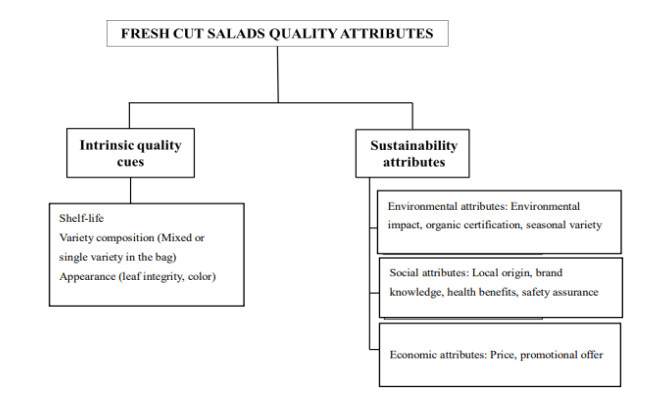









 DownLoad:
DownLoad:
